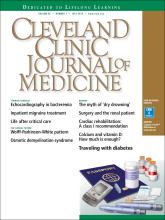Article Figures & Data
Tables
MAJOR CRITERIA Positive microbiologic findings Two separate blood cultures positive for typical microorganisms causing infective endocarditis: Staphylococcus aureus, Viridans-group streptococci, Streptococcus gallolyticus, enterococci, and “HACEK-group” organisms (Haemophilus species, Aggregatibacter species, Cardiobacterium hominis, Eikenella corrodens, and Kingella species) Persistently positive blood cultures: ie, 2 cultures at least 12 hours apart positive for typical pathogens, and at least 3 of 4 cultures positive for pathogens commonly considered as skin contaminants (Staphylococcus epidermidis) A single blood culture positive for Coxiella burnetii, or an immunoglobulin G titer > 1:800 Echocardiographic findings Valvular vegetation, abscess, dehiscence of prosthetic valve, or new valvular regurgitation MINOR CRITERIA Clinical predisposition: intravenous drug use, presence of a prosthetic heart valve or material, history of valvular disease Microbiologic findings: positive findings on microbiologic study other than those in the major criteria Body temperature ≥ 38.0 °C (100.4 °F) Vascular findings: embolization, mycotic aneurysm, conjunctival hemorrhage, Janeway lesions Immunologic findings: glomerulonephritis, Osler nodes, Roth spots, positive rheumatoid factor Based on information in reference 7.
Definite infective endocarditis:
Confirmed by pathology studies
Meets 2 major Duke criteria
Meets 1 major and 3 minor criteria
Meets 5 minor clinical criteriaPossible infective endocarditis:
Meets 1 major and 1–2 minor criteria
Meets 3–4 minor criteriaRules out infective endocarditis:
Pathology studies negative
An alternative diagnosis is present
Rapid clinical improvement within 4 days of starting antibiotic treatment






